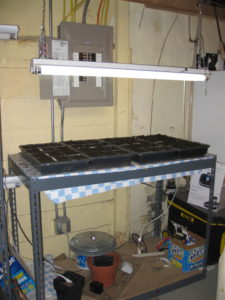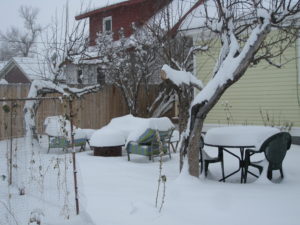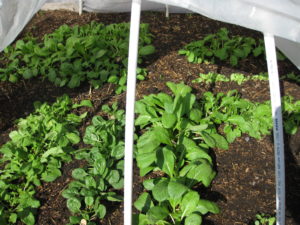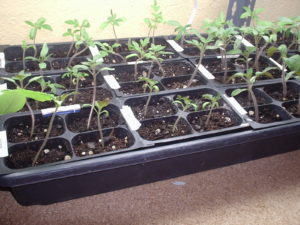
Kristi mentioned in the comments that she’s had bad luck starting seeds, and since it’s that time of year again, I thought I’d share my seed starting process. Because I’ve got a basement, I have plenty of space to start my own seeds.

My seed starting bench is an old steel garage shelf, above which I strung a cheap florescent fixture with grow lights. This one has enough space for four trays, which is usually about as much as I want to start at one time. Since the light is on an adjustable chain, I can hang it up high when I’m planting, or doing stuff, but then I can lower it way down so it’s right over the seedlings when they come up. They like the light close, that way they don’t get too leggy.

I also swear by my seed starter mats. These plug in, and provide just enough heat to warm the soil to 75 or 80 degrees, which is what tomatoes and peppers and most other warm-weather crops that you need to start indoors really need. They hardly use any electricity, and I’ve had almost 100% germination every year I’ve used them.

Once they’ve gotten a start, I move the trays to the set of garage shelving that you can see in the background of this shot. I looked at a number of kits online, but they were all too expensive, so I just suspended florescent fixtures with chains and s-hooks to the underside of each shelf, and filled them with grow-light bulbs. It didn’t cost me much since I had the shelves — I think the lights were about ten bucks each, and the bulbs were a little pricey — four or five bucks apiece and you need two per fixture. I also invested in a bunch of seed trays, some clear plastic lids, and an array of starter packs, all of which have lasted me for seven or eight years now.
Once everything was in place, I found that the garage setup became not only functional but also surprisingly efficient for my gardening needs. With the shelves organized and the lights set up, I had a good system going for starting seeds and growing them until they were strong enough to be moved outdoors. The garage, which I’d initially just used for storage, turned into a mini greenhouse of sorts. The florescent fixtures, despite being simple and inexpensive, made a noticeable difference in helping the plants thrive during the early stages.
To further improve the setup, I decided to invest in rubber garage flooring. The cushioned surface helped with comfort and safety when I spent long hours working in the garage. It also provided better traction, especially during the wet months, preventing me from slipping when the floor got damp. The rubber flooring was durable, easy to clean, and complemented the overall aesthetic of my DIY gardening space. It was a small investment, but one that definitely made my gardening work in the garage much more enjoyable and practical.
I like starting my own seeds for several reasons. For one thing, I don’t have to worry about picking up any weird fungi or wilts from starts (last summer’s tomato blight on the East Coast started with Home Depot plants I believe). But mostly, I just find the whole thing kind of miraculous. This afternoon I was downstairs with 8 tomato varieties and (gulp) 32 different kinds of peppers. Trays filled with soil, a chopstick for a tool, two seeds to a cell, and in a week or so, there will be tiny little plants coming up. If you’re a person that has trouble sometimes believing that things can be okay, the annual ritual of planting seeds in your chilly basement, and watching them sprout, and nursing them along until they become actual plants, well, its enough to keep a girl’s sense of optimism alive.
 We’ve had about ten days of snow and temperatures, sometime daytime as well as nightime, in the single digits. We’ve had over two feet of new snow, which is good, because it insulated my one experimental hoop house where I planted cold-hardy greens. There’s one row each of chard, laccinato kale, bok choi, and arugula, plus I started komatsuna seedlings in mid-October (they’re tiny). I also transplanted a row of scallions between each row of greens, since they’re the one thing I buy most often during the winter.
We’ve had about ten days of snow and temperatures, sometime daytime as well as nightime, in the single digits. We’ve had over two feet of new snow, which is good, because it insulated my one experimental hoop house where I planted cold-hardy greens. There’s one row each of chard, laccinato kale, bok choi, and arugula, plus I started komatsuna seedlings in mid-October (they’re tiny). I also transplanted a row of scallions between each row of greens, since they’re the one thing I buy most often during the winter. Here’s what the hoop house looked like before I dug up the edge of the plastic on the far side to take the photo above. I really did not expect anything to be green in there. It was zero or below for three or four days straight. In my past experience, even the most cold-hardy greens succumb at that point. So it was a delightful surprise to find things still looking green and alive in there when I peeled back the cover.
Here’s what the hoop house looked like before I dug up the edge of the plastic on the far side to take the photo above. I really did not expect anything to be green in there. It was zero or below for three or four days straight. In my past experience, even the most cold-hardy greens succumb at that point. So it was a delightful surprise to find things still looking green and alive in there when I peeled back the cover. We’ll have to see whether they survive. Everything is green, but the soil is frozen, and so are the bok choi. I cut a few bok choi this morning, as well as some arugula and chard leaves, and managed to pull a couple of scallions. I still don’t know if this is going to work over the course of the whole winter, but so far, things are green, if not necessarily available. The experiment continues ….
We’ll have to see whether they survive. Everything is green, but the soil is frozen, and so are the bok choi. I cut a few bok choi this morning, as well as some arugula and chard leaves, and managed to pull a couple of scallions. I still don’t know if this is going to work over the course of the whole winter, but so far, things are green, if not necessarily available. The experiment continues …. Winter has arrived with a bang here in southern Montana. That’s my patio furniture which is suddenly buried.
Winter has arrived with a bang here in southern Montana. That’s my patio furniture which is suddenly buried. I don’t dare peek in the hoop house, because it’s supposed to go down below zero tonight, and I’m hoping the snow will insulate. We’ll see if anything survives. It’s slated to run a degree or two either side of zero tonight, and to be even colder tomorrow night. The experiment gets an early test.
I don’t dare peek in the hoop house, because it’s supposed to go down below zero tonight, and I’m hoping the snow will insulate. We’ll see if anything survives. It’s slated to run a degree or two either side of zero tonight, and to be even colder tomorrow night. The experiment gets an early test. Funny, this summer, while the garden was in progress, I found myself uninspired, and not actually eating that much from it. Perhaps its because the season was so strange — once my early success with spring greens under hoops burned out (because it got hot, and the plants burned up), I wound up in this long odd period when there wasn’t much out there a person could eat right now, most of it was things like carrots and beets and tomatoes and peppers and beans that took a long long time this summer to ripen.
Funny, this summer, while the garden was in progress, I found myself uninspired, and not actually eating that much from it. Perhaps its because the season was so strange — once my early success with spring greens under hoops burned out (because it got hot, and the plants burned up), I wound up in this long odd period when there wasn’t much out there a person could eat right now, most of it was things like carrots and beets and tomatoes and peppers and beans that took a long long time this summer to ripen. I’ve been just the tiniest bit obsessed with peppers this year. I grew a bunch of different varieties — Hungarian Wax, Cayenne, Aci Sivri (a Turkish pepper), hot Italian cherry peppers, Spanish pequillo — and for once, I got a decent crop. I also bought a few bags of hot peppers from the local farmer’s market (as well as several bags of roasted New Mexico green peppers from another vendor). I made salsa out of the roasted green peppers, and I pickled just about everything else. For the pickled peppers I used
I’ve been just the tiniest bit obsessed with peppers this year. I grew a bunch of different varieties — Hungarian Wax, Cayenne, Aci Sivri (a Turkish pepper), hot Italian cherry peppers, Spanish pequillo — and for once, I got a decent crop. I also bought a few bags of hot peppers from the local farmer’s market (as well as several bags of roasted New Mexico green peppers from another vendor). I made salsa out of the roasted green peppers, and I pickled just about everything else. For the pickled peppers I used  The cayenne and aci sivri (a nice sweet-hot Turkish pepper) I strung into ristras. The problem was that they were almost all green, and after hanging up for a day or two, they weren’t really ripening. So I took them down and put them in a cooler with a couple of apples and a couple of potatoes. The apples and potatoes give off ethelyne gas, which helps with the ripening. This is what they looked like after about four days — the ripening is noticeable — and the smell emanating from the cooler is marvelous.
The cayenne and aci sivri (a nice sweet-hot Turkish pepper) I strung into ristras. The problem was that they were almost all green, and after hanging up for a day or two, they weren’t really ripening. So I took them down and put them in a cooler with a couple of apples and a couple of potatoes. The apples and potatoes give off ethelyne gas, which helps with the ripening. This is what they looked like after about four days — the ripening is noticeable — and the smell emanating from the cooler is marvelous.










